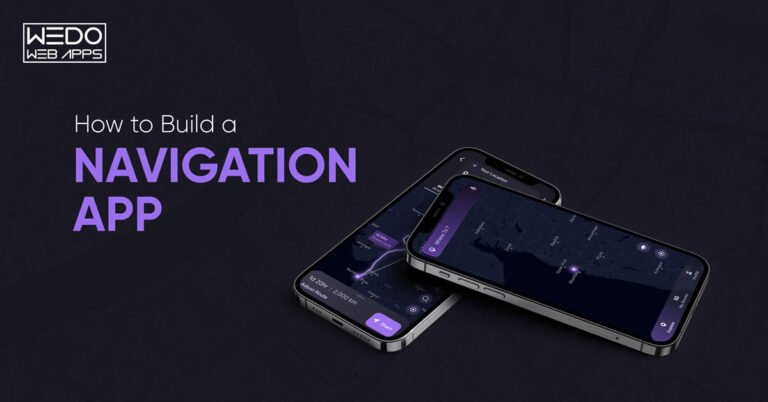6 Jun, 2023 | Mobile App Development
How to Build a Navigation App

A Step-by-Step Guide on How to Build a Navigation App
Navigation apps are becoming increasingly popular, as people rely on them for everything from getting around town to planning long-distance trips. If you're thinking about building your own navigation app and want’s to know about how to create a navigation app there are a few things you need to know.Choosing the right platform
The first step is to choose the right platform for your app. The two most popular platforms for navigation apps are Android and iOS. Android is the most popular platform for mobile devices, with a market share of over (70%). iOS is the second most popular platform, with a market share of over 20%. If you're uncertain about the platform selection, take into account your target demographic. If you're targeting a global audience, Android is a good choice. If you're targeting a specific region or country, iOS may be a better option.Finding a map provider
The next step is to find a map provider. There are a number of different map providers available, including Google Maps, Apple Maps, and TomTom. Each provider has its own strengths and weaknesses, so it's important to do your research and choose the provider that's right for your app. Google Maps is the most popular map provider, and it offers a wide range of features, including turn-by-turn navigation, voice guidance, traffic updates, and public transportation support. Apple Maps is the default map provider for iOS devices, and it offers a similar set of features to Google Maps. TomTom is a lesser-known map provider, but it offers some unique features, such as offline maps and live traffic updates.Designing your app
Once you've chosen a platform and a map provider, it's time to start designing your app. This includes creating the user interface, adding features, and testing your app. The user interface is the most important part of your app. It ought to possess user-friendly features, ensuring effortless navigation. The user interface should also be consistent with the platform you're using. For example, if you're developing an Android app development, the user interface should follow the Material Design guidelines. The features you add to your app will depend on your target audience and your budget. However, some common features include:Turn-by-turn navigation:
This is the most important feature for any navigation app. It allows users to see their route on a map and get turn-by-turn instructions.Voice guidance:
This feature allows users to hear their directions spoken aloud. This can be helpful for drivers who need to keep their eyes on the road.Traffic updates:
This feature provides users with real-time traffic information. This can help users avoid traffic jams and get to their destination faster.Public transportation support:
This feature allows users to plan trips using public transportation. This can be helpful for users who don't have a car or who want to avoid traffic.Customization options:
Allow users to customize their app experience by choosing their preferred map style, voice guidance language, and other settings.
Testing your app
Once you've added all of the features you want, it's important to test your app thoroughly. This includes testing on a variety of devices and in different environments. You can test your app on your own devices or you can consult with Mobile App Development Agency, it's also a good idea to get feedback from other people. You can do this by asking friends and family to test your app, or by posting it on a beta testing website.Publish your app
Once you're satisfied with your application, you can release it to the app store. The process for publishing an app to the app store is different for Android and iOS. For Android, you need to create a developer account and submit your app to the Google Play Store. For iOS, you need to create an Apple Developer account and submit your app to the App Store.Conclusion
Building a navigation app is a complex process, but it can be a rewarding one. By following the steps outlined in this article, you can create a navigation app that people will love to use. Here are some additional tips for building a successful navigation app:- Make sure your app is easy to use. The UI should be user-friendly and offer seamless navigation.
- Provide accurate and up-to-date information. Your app should use the latest map data and traffic information.
- Keep your app up-to-date. Release regular updates with new features, bug fixes, and security patches.
- Promote your app. Let people know about your app through social media, advertising, and other marketing channels.
Frequently Asked Questions
The two most popular platforms for navigation apps are Android and iOS. Android is the most popular platform for mobile devices, with a market share of over 70%. iOS is the second most popular platform, with a market share of over 20%.
Some of the most popular map providers for navigation apps include Google Maps, Apple Maps, and TomTom. Google Maps is the most popular map provider, and it offers a wide range of features, including turn-by-turn navigation, voice guidance, traffic updates, and public transportation support. Apple Maps is the default map provider for iOS devices, and it offers a similar set of features to Google Maps. TomTom is a lesser-known map provider, but it offers some unique features, such as offline maps and live traffic updates.
It's important to test your navigation app thoroughly before publishing it. This includes testing on a variety of devices and in different environments. You can test your app on your own devices, but it's also a good idea to get feedback from other people. You can do this by asking friends and family to test your app, or by posting it on a beta testing website.

